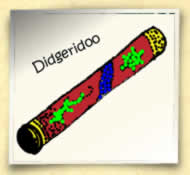Meet the Didgeridoo
If you've ever seen a movie or TV program about Australia - you've certainly heard this instrument! According to legend, the Australian ancestors were camping one night and it became cold. One ancestor went to find firewood and was about to throw a hollow log into the fire when he noticed small white ants inside of it. Wishing not to harm any living creature, he took the stick and gently blew out the ants, creating an amazing noise that is eerie, funny, strange and very cool! That's how the didgeridoo was created!
Originally made from a hollow tree branch, you can make yours from a number of different materials - simple ones from rolls from wrapping paper, mailing tubes or more complex ones from pvc piping sold in a hardware store.
What kind of sounds will yours make for you?
Make It!
You need to start with a long, hollow object. Pick one of the following - wrapping paper rolls, mailing tubes or a length of pvc piping cut to your order at a hardware stores. (You can also use paper towel and TP rolls - but the sound is better on longer didg's). If you are using the pvc piping, make sure you also buy sand paper and sand the rough edges so as not to cut mouths or hands on the instrument.
Decorate It!
For the simpler didg's made from paper products, use stickers, paint, sharpie pens or ribbon. You can also make woven bracelets or feathered handles for your instrument. Be creative and have fun. For the pvc didgeridoo, sharpie pens work best. Make a design that is special to you - most traditional didgeridoos have an animal on it like a lizard or a snake or something that is special to the instrument's owner. And most traditional designs are made of a series of dots. You can make one that looks like something from the outback or one that is more modern as well!
Play It!
Technically, the didg is played by "blowing raspberries" into it. Let air pass through your lips while they blow back and forth. You can also simply hum or speak into it and notice how different sounds change as they pass through your instrument. With younger children, try saying their name or a series of vowels (like A-E-I-O-U) and hear how these sounds transform as they pass through the sound tube. For advanced players, you may wish to try "circular breathing", This means that you blow out of your mouth while breathing air in through your nose. This is not easy, but worth a try! If done correctly, a didg player can make his instruments sing for ten, twenty minutes or longer! One player that I know tells stories and his didg helps make sound effects and animal voices for his Australian tales.








